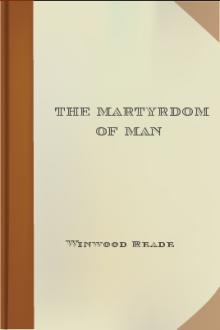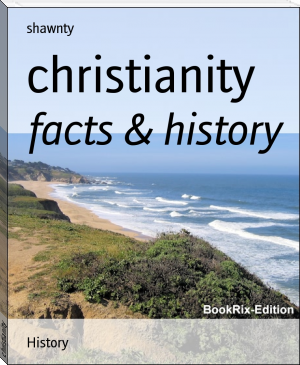The Martyrdom of Man by Winwood Reade (mini ebook reader .TXT) 📕

- Author: Winwood Reade
- Performer: -
Book online «The Martyrdom of Man by Winwood Reade (mini ebook reader .TXT) 📕». Author Winwood Reade
behaved unkindly to a beggar, and so immortalised his own offence. He
issued a text, “Use no violence in religion.”
But this text, with many others, he afterwards expunged. When he
arrived at Medina he found himself at the head of a small army, and he
began to publish his gospel of the sword. Henceforth we may admire the
statesman or the general; the prophet is no more. It will hence be inferred
that Mohammed was hypocritical, or at least inconstant. But he was
constant throughout his life to the one object which he had in view—the
spread of his religion. At Mecca it could best be spread by means of the
gentle virtues; he therefore ordered his disciples to abstain from violence
which would only do them harm. At Medina he saw that the Caaba
idolatry could not be destroyed except by force; he therefore felt it his
duty to make use of force. He obeyed his conscience both at Mecca and
Medina, for the conscience is merely an organ of the intellect, and is
altered, improved, or vitiated according to the education which it receives
and the incidents which act upon it.
And now Mohammed’s glory expanded, and at the same time his virtue
declined. He broke the Truce of God: he was not always true to his
plighted word. As Moses forbade the Israelites to marry with the pagans
and then took unto himself an Ethiopian wife, so Mohammed, broke his
own marriage laws, beginning the career of a voluptuary at fifty years of
age. His Koran sudras were now official manifestoes, legal regulations,
delivered in an extravagant and stilted style differing much from that of
his fervid oracles at Mecca. But whatever may have been his private
defects, when we regard him as a ruler and lawgiver we can only wonder
and admire. He established for the first time in history a united Arabia.
In the moral life of his countrymen he effected a remarkable reform. He
abolished drunkenness and gambling—vices to which the Arabs had been
specially addicted. He abolished the practice of infanticide, and also
succeeded in rendering its memory detestable. It is said that Omar, the
fierce apostle of Islam, shed but one tear in his life, and that was when he
remembered how in the days of darkness his child had beat the dust off
his beard with her little hand as he was laying her in the grave. Polygamy
and slavery he did not prohibit, but whatever laws he made respecting
women and slaves were made with the view of improving their condition.
He removed that facility of divorce by means of which an Arab could at
any time repudiate his wife: he enacted that no Moslem should be made a
slave, that the children of a slave girl by her master should be free.
Instead of repining that Mohammed did no more, we have reason to be
astonished that he did so much. His career is the best example that can be
given of the influence of the individual in human history. That single
man created the glory of his nation and spread his language over half the
earth. The words which he preached to jeering crowds twelve hundred
years ago are now being studied by scholars or by devotees in London
and Paris and Berlin; in Mecca, where he laboured, in Medina, where he
died; in Constantinople, in Cairo, in Fez, in Timbuktu, in Jerusalem, in
Damascus, in Basra, in Baghdad, in Bokhara, in Kabul, in Calcutta, in
Pekin; on the steppes of Central Asia, in the islands of the Indian
Archipelago, in lands which are as yet unmarked upon our maps, in the
oases of thirsty deserts, in obscure villages situated by unknown streams.
It was Mohammed who did all this, for he uttered the book which carried
the language, and he prepared the army which carried the book. His
disciples and successors were not mad fanatics but resolute and sagacious
men, who made shrewd friendship with the malcontent Christians among
the Greeks and with the persecuted Jews in Spain, and who in a few years
created an empire which extended from the Pyrenees to the Hindu Kush.
This empire, it is true, was soon divided, and soon became weak in all its
parts. The Arabs could conquer, but they could not govern. Separate
sovereignties or caliphates were established in Babylonia, Egypt, and
Spain, while provinces such as Morocco or Bokhara frequently obtained
independence by rebellion. It is needless to describe at length the history
of the Caliphs and their successors—it is only the twice-told tale of the
Euphrates and the Nile. The caliphs were at first Commanders of the
Faithful in reality, but they were soon degraded both in Cairo and
Baghdad to the position of the Roman Pope at the present time. The
government was seized by the Praetorian Guards, who in Baghdad were
descended from Turkish prisoners or negroes imported from Zanzibar,
and in Egypt from Mamelukes or European slaves, brought in their
boyhood from the wild countries surrounding the Black Sea, and trained
up from tender years to the practice of arms—the sons of Christian
parents, but branded with a cross on the soles of their feet that they might
never cease to tread upon the emblem of their native creed.
However, by means of the Arab conquest the East was united as it had
never been before. The Euphrates was no longer a line of partition
between two worlds. Arab traders established their factories on both
sides of the Indian Ocean and along the Asiatic shores of the Pacific.
Men from all countries met at Mecca once a year. The religion of the
Arabs conquered nations whom the Arabs themselves had never seen.
When the Mohammedan Turks of Central Asia took Constantinople and
reduced the caliphates to provinces, although the people of Mohammed
were driven back to their wilderness the strength and glory of his religion
was increased. In the same manner the conquest of Hindustan was an
achievement of Islam in which the Arabs bore no part, and in Africa also
we shall find that the Koran reigns over extensive regions which the
Arabs visit only as travellers and merchants.
Once upon a time Morocco and Spain were one country, and Europe
extended to the Atlas mountains, which stood upon the shores of a great
salt sea. Beyond that ocean, to the south, lay the Dark Continent,
surrounded on all sides by water except on the north-east, where it was
joined to Asia near Aden by an isthmus. A geological revolution
converted the African ocean into a sandy plain, and the straits of Bab-el-Mandeb and Gibraltar were torn open by the retreating waves. But the
Sahara, though no longer under water, is still in reality a sea; the true
Africa begins on its southern coast, and is entirely distinct from the
European-like countries between the Mediterranean and the Atlas, and
from the strip of garden land which is cast down every year in the desert
by the Nile. The Black Africa or Sudan is a gigantic tableland; its sides
are built of granite mountains which surround it with a parapet or brim,
and which send down rivers on the outside towards the sea, on the inside
into the plateau. The outside rivers are brief and swift: the inside rivers
are long and sluggish in their course, winding in all directions, collecting
into enormous lakes, and sometimes flowing forth through gaps in the
parapet to the Sahara or the sea.
A tableland is seldom so uniform and smooth as the word denotes. The
African plateau is intersected by mountain ranges and ravines, juts into
volcanic isolated cones, and varies much in its climate, its aspect, its
productions, and its altitude above the sea. It may be divided into
platforms or river basins which are true geographical provinces, and each
of which should be labelled with the names of its explorers. There is the
platform of Abyssinai, which belongs to Bruce; the platform of the White
Nile, including the Lakes of Burton (Tanganyika), of Speke (Victoria
Nyanza), and of Baker (Albert Nyanza); the platform of the Zambezi,
with its lakes Nyasa and Ngami, discovered by Livingstone, the greatest
of African explorers; the platform of the Congo, including the regions of
Western Equatorial Africa, hitherto unexplored; the platform of South
Africa (below 20º S.), which enjoys an Australian climate, and also
Australian wealth in its treasure-filled mountains and its wool-abounding
plains; and lastly the platform of the Niger, which deserves a place, as
will be shown, in universal history. The discoverers of the Niger in its
upper are Park (who first saw the Niger), Caillie, and myself: in its
central and eastern parts Laing, who first reached Timbuktu; Caillie, who
first returned from it; Denham, Clapperton, Lander, and Barth.
The original inhabitants of Africa were the Hottentots or Bushmen, a
dwarfish race who have restless, rambling, ape-like eyes, a click in their
speech, and bodies which are the wonder of anatomists. They are now
found only on the South African platform, or perhaps here and there on
the platform of the Congo. They have been driven southward by the
negroes, as the Eskimos in America were driven north by the Red Indians
and the Finns in Europe by the Celtic tribes, while the negroes themselves
have yielded in some parts of Africa to Asiatic tribes, as the Celts in Gaul
and Britain yielded to the Germans.
These negroes are sometimes of so deep a brown that the skin appears to
be quite black; sometimes their skin is as light as a mulatto’s. The
average tint is a rich deep bronze. Their eyes are dark, though blue eyes
are occasionally seen; their hair is black, though sometimes of rusty red,
and is always of a woolly texture. To this rule there are no exceptions—it
is the one constant character, the one infallible sign by which the race
may be detected. Their lips are not invariably thick; their noses are
frequently well formed. In physical appearance they differ widely from
one another. The inhabitants of the swamps, the dark forests and the
mountains are flat-nosed, long armed, and thin-calved, with mouths like
mussles, broad splay feet, and projecting heels. It was for the most part
from this class that the American slave markets were supplied; the
negroes of the States and the West Indies represent the African in the
same manner as the people of the Pontine Marshes represent the
inhabitants of Italy. The negroes of South Africa stand at the opposite
extreme. Enjoying an excellent climate and a wholesome supply of food,
they are superior to most other people of their race. Yet it is certain that
they are negroes, for they have woolly hair, and they do not differ in
language or manners from the inhabitants of the other platforms. When
the Portuguese first traded on the African coasts they gave the name
Caffres (or pagans) to the negroes of Guinea, as well as to those of the
Cape and Mozambique. It is quite an accident that the name has been
retained for the latter tribes alone, yet such is the power of a name that the
Caffres and negroes are universally supposed to be distinct. It is
impossible, however, to draw any line between the two. Pure negroes are
born on the coast of Guinea and in the interior with complexions as light,
with limbs as symmetrical, and with features as near to the European
standard as can be found in all Caffraria. Between the hideous being of
the Nile and Niger deltas and the robust shepherds of the south, or the
aristocratic chieftains of the west, there is a wide difference, no doubt but
intermediate gradations exist.
There is also much variety among the negroes in respect to manners,
mental condition, political government, and mode of life. Some tribes
live only





Comments (0)